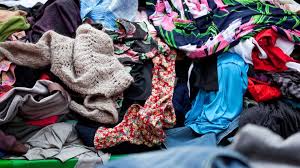Clothes: A Reflection of Style, Identity, and Self-Expression
Clothes have always played a significant role in human society. Beyond their basic purpose of providing protection and warmth, clothes have evolved to become an essential means of self-expression, style, and identity. From the earliest civilizations to the modern fashion industry, clothing choices have been deeply intertwined with culture, social status, and personal preferences.
One of the most fascinating aspects of clothing is its ability to convey messages about who we are as individuals. Our choice of attire can reflect our personality traits, interests, and even our values. Whether it’s a bold statement piece or a subtle accessory, every item we wear contributes to our overall image.
Fashion trends come and go, but personal style remains timeless. Each person has their unique fashion sense that allows them to stand out from the crowd. Some may prefer classic elegance while others lean towards edgier or more casual looks. The beauty lies in the diversity of styles that exist – there is no one-size-fits-all approach when it comes to fashion.
Moreover, clothing choices can also be influenced by cultural norms and traditions. Different regions around the world boast their distinct fashion customs that reflect their heritage and history. Traditional garments serve not only as a way to preserve cultural identity but also as a source of pride for many communities.
The fashion industry itself plays a pivotal role in shaping trends and influencing consumer choices. Designers constantly push boundaries by introducing new designs, materials, and techniques. Fashion shows become platforms for creativity and innovation where designers showcase their artistic vision to captivate audiences worldwide.
However, it is important to acknowledge that the fast-paced nature of the fashion industry has led to concerns regarding sustainability and ethical practices. The rise of fast fashion has resulted in environmental issues due to excessive production waste and unethical labor practices in some parts of the world. As consumers become more conscious about these issues, there is an increasing demand for sustainable and ethically produced clothing options.
Clothes have the power to make us feel confident, comfortable, and empowered. The right outfit can boost our mood, enhance our self-esteem, and leave a lasting impression on others. It is not just about following trends but rather embracing clothes as a means of self-expression and celebrating our individuality.
In conclusion, clothes are much more than just fabric draped on our bodies. They are an extension of ourselves – a canvas through which we can showcase our unique style, cultural heritage, and personal identity. Whether we follow the latest fashion trends or create our own fashion rules, clothes allow us to express ourselves in ways that words sometimes cannot. So next time you choose your outfit for the day, remember that you are not just getting dressed; you are telling the world who you are.
Commonly Asked Questions About Clothes: A Guide for Fashion Enthusiasts in the UK
- What is the best way to care for my clothes?
- What are the latest fashion trends?
- How can I make my clothes last longer?
- Where can I buy affordable quality clothing?
- How do I choose the right size when buying clothes online?
What is the best way to care for my clothes?
Caring for your clothes properly is essential to ensure their longevity and maintain their quality. By following a few simple guidelines, you can keep your garments looking their best for longer. Here are some tips on how to care for your clothes:
- Read the care labels: Care labels provide important instructions specific to each garment. They indicate the recommended washing method, water temperature, and whether the item can be machine washed or needs to be hand washed. Always follow these instructions to avoid damaging your clothes.
- Sort your laundry: Sort your laundry into different piles based on color and fabric type. Washing dark and light colors separately helps prevent color bleeding and fading. Delicate fabrics like silk or lace should be washed separately or placed in a mesh laundry bag to protect them.
- Use appropriate washing techniques: When using a washing machine, select the appropriate cycle for the fabric type and soil level indicated on the care label. Avoid overloading the machine as it can lead to inadequate cleaning or excessive wear on the clothes. For hand-washing delicate items, use mild detergents specifically formulated for delicate fabrics.
- Wash in cold water: Washing clothes in cold water not only saves energy but also helps preserve colors and prevent shrinkage. Cold water is generally suitable for most fabrics unless otherwise specified on the care label.
- Treat stains promptly: Address stains as soon as possible to increase the chances of successful removal. Follow stain removal guidelines based on the type of stain and fabric involved. Avoid rubbing vigorously as it can damage fibers; instead, gently blot or dab with a clean cloth.
- Dry clothes appropriately: Some garments may require air drying instead of using a dryer, especially delicate items prone to shrinking or fabric damage from high heat. Hanging clothes up to dry or laying them flat can help maintain their shape better.
- Iron with care: Ironing can smooth out wrinkles and give your clothes a polished look, but it’s important to use the appropriate heat setting for each fabric. Iron clothes inside out when possible, and avoid ironing directly over prints or embellishments.
- Store clothes properly: Proper storage helps prevent wrinkles, stretching, and damage. Hang garments that are prone to wrinkling, such as dresses and shirts, on sturdy hangers. Fold items like sweaters or knits to avoid stretching them on hangers. It’s also a good idea to store clothes in a clean, dry place away from direct sunlight.
By following these care tips, you can extend the lifespan of your clothes and keep them looking fresh and well-maintained. Remember that each garment may have specific care requirements, so always refer to the care labels for individual instructions.
What are the latest fashion trends?
Fashion trends are constantly evolving, influenced by various factors such as runway shows, celebrity styles, street fashion, and social media. Here are some of the latest fashion trends that have been making waves:
- Pastel Colors: Soft pastel shades like lavender, mint green, baby blue, and blush pink have been dominating the fashion scene. These gentle hues bring a sense of tranquility and freshness to any outfit.
- Oversized Blazers: Oversized blazers have become a staple in many wardrobes. They add a touch of sophistication and can be styled in multiple ways – from pairing them with jeans for a casual look to layering over dresses for a more polished ensemble.
- Wide-Leg Trousers: Wide-leg trousers are making a comeback this season. These flowy and comfortable bottoms offer a relaxed yet chic look that can be dressed up or down depending on the occasion.
- Statement Sleeves: Dramatic sleeves are having a moment. Whether it’s puffed sleeves, bishop sleeves, or balloon sleeves, these eye-catching details add flair and femininity to tops and dresses.
- Chunky Boots: Chunky boots have become a must-have footwear choice for both men and women. Their sturdy and edgy appeal adds an interesting contrast to feminine outfits while providing comfort and practicality.
- Sustainable Fashion: With increasing awareness about environmental issues, sustainable fashion has gained significant popularity. People are opting for eco-friendly materials, ethical production practices, and second-hand or vintage clothing to reduce their impact on the environment.
- Athleisure: The athleisure trend continues to thrive as people embrace comfortable yet stylish activewear in their everyday outfits. Leggings, hoodies, joggers, and sneakers are being incorporated into casual looks for both leisure activities and urban streetwear.
- Floral Prints: Floral prints never go out of style but they continue to evolve each season. This year, bold and vibrant floral patterns are making a statement, adding a touch of romance and playfulness to various garments.
- Elevated Loungewear: With the rise of remote work and stay-at-home lifestyles, elevated loungewear has become popular. Think cozy knit sets, stylish joggers, and luxe loungewear pieces that are comfortable yet chic enough for video calls or quick outings.
- Statement Accessories: Bold accessories are an easy way to elevate any outfit. Chunky chain necklaces, oversized sunglasses, statement belts, and embellished headbands are some of the accessories that have been in the spotlight recently.
Remember that fashion trends are subjective and can vary based on personal style preferences. It’s always important to choose trends that resonate with your own sense of style and make you feel confident and comfortable.
How can I make my clothes last longer?
Making your clothes last longer not only helps you save money but also contributes to reducing waste and promoting sustainability. Here are some tips to help extend the lifespan of your garments:
- Follow care instructions: Always read and follow the care labels on your clothes. Different fabrics require specific care methods such as handwashing, machine washing, or dry cleaning. Following these instructions will prevent damage and maintain the quality of your clothing.
- Wash less frequently: Avoid washing clothes unnecessarily after every wear, especially items like jeans or sweaters that are not visibly dirty or sweaty. Overwashing can cause fabric fibers to break down more quickly. Instead, spot clean stains and hang garments in a well-ventilated area to freshen them up between washes.
- Use gentle cycles and cold water: When you do wash your clothes, opt for gentle cycles and use cold water whenever possible. Hot water can fade colors and shrink certain fabrics. Additionally, using a gentle cycle reduces the stress on your garments during washing.
- Sort laundry properly: Sort your laundry by color and fabric type before washing to avoid color bleeding or damage caused by rougher fabrics rubbing against delicate ones.
- Use appropriate laundry detergents: Choose mild detergents that are suitable for the type of fabric you’re washing. Harsh chemicals can weaken fibers over time, leading to faster wear and tear.
- Turn clothes inside out: Turning garments inside out before washing helps protect delicate prints, embellishments, and prolongs the life of colors.
- Hang dry when possible: Heat from dryers can be harsh on fabrics, causing shrinkage or weakening of fibers. Whenever possible, air-dry your clothes on a drying rack or hanger.
- Store clothing properly: Fold clothes neatly or hang them on appropriate hangers when storing them in closets or drawers to prevent wrinkles, stretching, or misshaping.
- Mend minor damages promptly: Don’t let small rips, loose buttons, or loose threads go unattended. Mend them promptly to prevent further damage.
- Rotate your wardrobe: Regularly rotate and alternate the use of your clothes. This helps distribute wear and tear more evenly across your wardrobe.
By following these simple practices, you can significantly extend the lifespan of your clothes, reduce the need for frequent replacements, and contribute to a more sustainable fashion consumption approach.
Where can I buy affordable quality clothing?
Finding affordable and quality clothing can be a challenge, but there are several options available to suit different budgets and preferences. Here are a few places where you can often find affordable yet well-made clothing:
- Thrift Stores: Thrift stores or second-hand shops are treasure troves for finding affordable clothing. You can discover unique pieces and even high-end brands at significantly reduced prices.
- Online Marketplaces: Websites like eBay, Depop, and Poshmark offer a wide range of pre-owned clothing at affordable prices. These platforms allow individuals to sell their gently used items, often offering good deals on quality pieces.
- Outlet Stores: Outlet malls or online outlet websites are great for finding discounted clothing from popular brands. These stores usually offer last season’s items or overstocked merchandise at reduced prices.
- Sales and Clearance Sections: Keep an eye on sales and clearance sections in physical stores or on the websites of your favorite brands. They often offer significant discounts on older inventory or seasonal items.
- Online Fast Fashion Retailers: While fast fashion has its drawbacks in terms of sustainability, some online retailers specialize in providing trendy and affordable clothing options. Examples include ASOS, Boohoo, PrettyLittleThing, and Missguided.
- Local Markets and Independent Boutiques: Check out local markets or independent boutiques in your area for unique and reasonably priced clothing made by local designers or artisans.
- Subscription Services: Clothing subscription services like Rent the Runway or Le Tote offer the opportunity to rent designer clothes at a fraction of their original cost, allowing you to enjoy high-quality garments without breaking the bank.
Remember that affordability doesn’t necessarily mean compromising on quality. It’s essential to check customer reviews, fabric composition, and product details before making a purchase to ensure you are getting good value for your money.
How do I choose the right size when buying clothes online?
Choosing the right size when buying clothes online can be a bit challenging, as you don’t have the opportunity to try them on before making a purchase. However, with a few helpful tips, you can increase your chances of finding the perfect fit. Here’s a guide to help you choose the right size when shopping for clothes online:
- Know Your Measurements: Take accurate measurements of your body before shopping online. Measure your bust, waist, hips, and inseam (for pants) using a measuring tape. Refer to the size chart provided by the retailer and compare your measurements to find the closest match.
- Check the Size Chart: Every online retailer typically provides a size chart specific to their brand or product. It is crucial to consult this chart as sizes may vary between different brands or even different items within the same brand. Pay attention to measurements rather than relying solely on generic sizing labels like small, medium, or large.
- Read Customer Reviews: Customer reviews can be extremely helpful in determining if an item runs true to size or if it is recommended to go up or down a size. Look for reviews from customers who have a similar body type as yours for more accurate insights.
- Consider Fabric and Style: Different fabrics and styles may fit differently even within the same size range. Stretchy materials tend to be more forgiving in terms of fit compared to non-stretch fabrics. Additionally, certain styles may be designed for loose or tight fits, so consider these factors when making your selection.
- Look for Size Guides: Some retailers provide additional information on how their garments fit by including specific details in their product descriptions or providing fitting recommendations for each item. This can give you valuable insights into whether you should opt for your usual size or make adjustments.
- Take Note of Return Policies: Before making a purchase, familiarize yourself with the retailer’s return policy regarding clothing items. Ensure that they offer hassle-free returns or exchanges in case the size or fit is not as expected.
- Seek Assistance: If you are unsure about sizing, don’t hesitate to reach out to the retailer’s customer service team. They can often provide guidance and answer any questions you may have regarding specific items or sizing concerns.
Remember, it’s better to err on the side of caution and choose a slightly larger size if you are uncertain. You can always have the garment altered by a tailor if needed. With careful attention to measurements, size charts, and customer reviews, you can increase your chances of finding the right size when shopping for clothes online.



